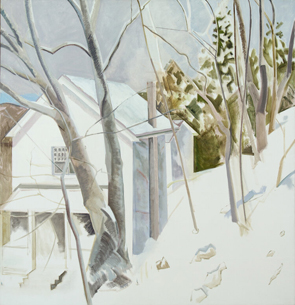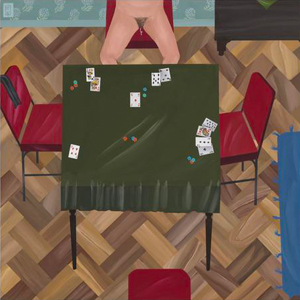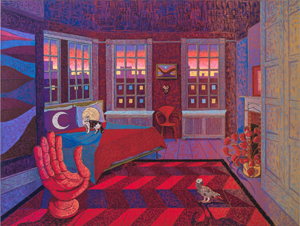The Lives of Others
John Haberin New York City
Lois Dodd, Anne Buckwalter, and J. J. Manford
Art can show you the lives of others and make them as familiar as your own. You can easily forget that it also telling stories. It is shaping the narrative of a life and your very sense of the familiar.
That is especially true of painting, with its tradition of self-expression—a tradition still celebrated and still under assault from modern and postmodern art. It can make you forget that artists might be working all along to create an identity, one work at a time, and only then to find out who and where they are. With gender identity in the foreground of contemporary art, it is good time to look again at artists, starting with women artists, and how they do it. Lois Dodd and Anne Buckwalter are skilled observers who keep their eye close to home. Generations apart, they turn to the scene in front of them for more than just self-affirmation and more than just a moment in time. As for the man of the house, J. J. Manford invites himself into the lives of others, in interiors that take on a life and color of their own, and I add a postscript for his progress just over two years later. 
The middle distance
Lois Dodd paints familiar places. Not that you necessarily recognize them, but you are all but certain to feel that you should. They exist in that middle distance between what you see and what you know. Her landscapes from some fifty years will be a discovery in more ways than one, as a former midtown gallery settles into the Lower East Side. She is in her nineties, and you can only wonder, too, where she has been all along. The answer, of course, is going about her work.
And then there is what she sees. She paints the view from her window in New York, overlooking a street as welcoming as its warm colors and closeness to the ground—and as forbidding as its closed, airless buildings. She paints a snowfall in New England and structures by her home in Maine, as near archetypes of the landscape. You will have seen them again and again, in Charles Burchfield and modern American art or in life. For all that, each has its particulars that no one could overlook.
The particulars can be generalized, too, though, like encroaching darkness for Dana Powell and Emily Nelligan. Where a city street is dark and enclosed, a staircase in New Jersey seems beyond reach in its icy whites and a tree in the dense atmosphere of falling snow. Barns, sheds, or rooms just down the hall have the cleaner, lighter colors of sunlight and fresh paint. Their geometry is equally crisp but strangely arbitrary. No one planned just how those buildings would appear together—or cut off by something as simple as a point of view. It is her point of view, in sticking to a moment in time where she works and lives.
I had encountered Dodd before in group shows, with another body of work not in the present show. It, too, has a distinct style and color, in accord with its subject. Flowers in close-up have brighter colors, hard edges, fuller shading, and the intensity of objects immediately at hand. Yet they, too, seem forever out of reach, like sunlight for Jessie Edelman, despite or even because of the point of view. People rarely speak of her work without pointing to its intimacy—like Lucy Lippard, who goes so far as to say that it is thus no longer landscape painting (as if landscape meant only the Romantic sublime). Still, the sense of distance remains along with the immediacy, in what might otherwise be Sunday painting, much as the artist at her easel in a self-portrait becomes only a mottled shadow.
Lippard, who wrote the catalog essay, may come as a surprise herself. A legendary critic, she has brought recognition to feminist art and Eva Hesse. A supporter of conceptual art as well, she described what a book called the dematerialization of the art object—the last thing that springs to mind when I, for one, think of Hesse, but crucial to her time all the same. Just as surprising, wall text quotes John Yao, a critic's critic who sticks reliably to abstract art. One can see, though, how Dodd has become a landscape painter for people who do not often fall in love with the landscape. A feminist would recall that she founded a gallery back in the 1950s as an artist collective, too, to keep otherwise neglected artists fully in the game.
Women artists have often found themselves in that more literal middle distance, just as in her paintings, ever so close and ever so far. I could almost reach out and touch the snow, but the tree remains beyond even the artist's reach. The view out her window extends only a few yards, in country or in city, but difficult yards to cross. Even if I could get outside, a tilted ground plane leaves no firm place to walk or to stand. One must settle for the familiar—and for those distinct sets of vivid colors. Yellow-orange, wintery whites, absent street lights, and more obviously absent people leave memories all their own.
The course of a life
You may think of a self-portrait as capturing a moment in time. You may think of it, too, as first and foremost a face—but not when it comes to Anne Buckwalter. A large show of small panels and works on paper traces the course of a life, even when no one is visible to claim it as her own. It is a personal life, filled with everyday objects and memories of a place to call home.  Home, in fact, provides the center of every scene and its boundaries in flooring, wall covering, bedspreads, and tablecloths. The odd window here and there could just as well be a painting within a painting, and it only calls attention to the limits of what she can see.
Home, in fact, provides the center of every scene and its boundaries in flooring, wall covering, bedspreads, and tablecloths. The odd window here and there could just as well be a painting within a painting, and it only calls attention to the limits of what she can see.
One thing on which we can agree: a portrait is a likeness, give or take the illusion and the lies, and Buckwalter is an illusionist but a teller of truths. A book, a glove, a backpack, or underwear lies wherever someone has left it, a chair wherever someone on rising pushed it back and aside. It only adds to the comforts of home that no one can be bothered to arrange a table, to make a bed, or, in a follow-up show, remove the evident traces of dirty sex. She paints, though, carefully though not meticulously, in gouache with clean lines—or, as the show's title has it, "Clean Linens." This is not photorealism but casual existence.
You may not see it right off as a life or, for that matter, as realism rather than decorative art. Flat surfaces take over the joint, most often as the picture plane, with the repeated patterns of floorboards, knit rugs, and floral wallpaper. Then, too, Buckwalter is not in the least a narrative painter, and her moments in time hang in no particular order, much like the furnishing here in a room. When you see the cover of a book, like Zadie Smith's White Teeth, you are bound to think of it as just now set aside. When you see an Etch-a-Sketch as the extent of someone's creativity, you have to assume that she has kids. Only when you get around to the titles can you see them as self-portraits, at age twenty-one and as a child.
Is it an accident that those correspond to formative moments, including the onset of adulthood? They, too, could just as well be accidents as much as choices. Still, Buckwalter is frank enough when it comes to relationships, and they do not look at all resolved. The clean patterns and the illusion of collage point to folk art in less modern communities, such as Shakers, but she is explicit enough when it comes to sex. The cards on a table do not look promising if you are looking to win, but this is a game of strip poker, and a naked body occupies the only filled chair. In this game, losers can also be winners.
Not that she seems to be having fun, with her head cut off by the picture's edge. Once again, a self-portrait is not necessarily her and not a face. When a woman sits apart, on the edge of a bed, there, too, the picture does not let on what she is seeing or feeling. One sees her from the back, bent over and isolated, maybe engaged in her hair. A mirror leaning awkwardly against a wall on the floor converts that pose into a splayed crotch, like manspreading but for a woman talking only to herself. Lovers seem to be struggling with one another or themselves.
Decorative art can mean obsessive pattering, and the gallery notes that the sex act mirrors the six-pointed star on a rug across the painting, to its left. The chairs pushed back pick up the zigzag of wood flooring. Still, Buckwalter is just as happy to let things lie. Sex here is not shocking after all, but one more part of life. Another book, Sylvia Plath's The Bell Jar, recalls an unhappy life, but the wintery scene out a window looks as warm as a snow globe. Who is to say whether this story has a happy ending?
Make yourself at home
A painting by J. J. Manford can change before your eyes from obsessive order to an unholy mess. These are interiors, from people with a sense of propriety and exquisite taste. They would never let ornamentation stand in the way of clean lines and New England wood.  They would never overfurnish or leave a dirty dish on the table. Nor would they intrude on a painting like his, not at the risk of upstaging the decor. Even their pets sit or stand on alert.
They would never overfurnish or leave a dirty dish on the table. Nor would they intrude on a painting like his, not at the risk of upstaging the decor. Even their pets sit or stand on alert.
Manford keeps things in order, too, until he runs way out of space. Windowpanes neatly frame the light from windows across the street, like an entire city in miniature and in close up. Risers in a banister frame the stairs as they double back on their way to an unseen higher floor. Striped carpeting on the lower steps falls right in line. Paintings on the wall fall in line with the architecture, too—or with the horizon out a window and the waves of light rising above.
From there, things do not so much fall apart as burst wide open. In another artist, such alignments could flatten the living quarters into formalism or the decorative arts, calling attention to their cleverness along the way. Manford is not so much punning on life and art as allowing their full colors to show. Abstract paintings within his paintings throb with the light and color of the setting sun. The view out the window becomes a painting in itself. If his compositions grow claustrophobic, one can feel the claustrophobia in the pit of one's stomach and right between the eyes.
The interior's collectibles become hard to recognize amid the overflow, but this is not a quiz. He is just admiring how much art can encompass and sharing his own tastes. They are eclectic tastes at that—and more than real-life inhabitants could likely afford. Feel equally drawn to Max Ernst between Surrealism and abstraction, Niki de Saint Phalle with her sexually charged childishness, Mose Toliver with his African American folk art, and Elizabeth Murray with painting flying off the wall? Ready to throw in a vase in the shape of a toucan, a rug with phases of the sun and moon, and a Tibetan tapestry? Make yourself at home.
Home has some other unlikely guests as well. A baby giraffe, poised beneath a painting by Alexander Calder, looks out upon a sun deck, lush grass, a dark mountain, and the throbbing sun. A stegosaurus the size of a puppy, a giant red hand, and a parrot claim the floor. They are just sculpture, right? No doubt, but then the stairs glow with a deep red that must be only natural, too, unless it is not. Paint itself can feel like a murder weapon or startling intruder. As Manford drags his brush across burlap, it brings out a stretch of blue, burning like fresh blue blood.
How can the wood of a chair have deep blue underpainting? Paint's sheer intensity matters more here than illusion. It could almost be bleeding out from within. Manford works on linen as well as a coarser ground, in oil stick, oil pastel, and Flashe, a still novel rubber-based paint, for their color and raw texture. You may have your reservations about the melodrama of crowded surfaces. Still, animals and abstraction here are equally fierce, in the space of the interior and in its art.
A postscript: Manford in 2024
Manford combines a dedication to neatness and order with an almost comic excess—of sunlight, color, and art-historical references. It is enough to put a fashionable property owner and follower of fashion to shame. Someone like that surely owns the interiors he depicts, at least in his imagination, but could easily run out of space. No wonder, then, that his scene has expanded, a few steps outdoors to survey the property or halfway inside to a greenhouse not for plants but for relaxing in the company of pets and possessions. If that amounts to a transitional space between inside and out, it suits objects that move casually between cultures. It suits, too, objects that may leave you wondering whether to call them posters and replicas or thefts from museums and other collections on behalf of some wealthy customers or the artist himself.
As ever, Manford works in a mix of oil stick, oil pastel, and Flashe, the vinyl-based paint, for tactile surfaces and clashing colors. Paintings within paintings let in the imagined sky, while glimpses outside could just as easily be works of art. Sculpture within a painting includes a colorful African god or warrior that has marched onto a coffee table where a proper collectible could hardly belong. As for the figurine on the sofa behind it, it could be part of a matched set or an intruder in disguise, but it owes just as much to Disney as to the Third World. Is this a sneak attack on the class that buys work like Manford's or a wish to have it all? Is it a model or a parody of "intersectionality"? I leave the rest of the story to my review from 2001.

Lois Dodd ran at Alexandre through October 23, 2021, Anne Buckwalter at Rachel Uffner through October 30, and J. J. Manford at Derek Eller through November 23. Buckwalter returned through November 4, 2023, Manford through February 3, 2024.




